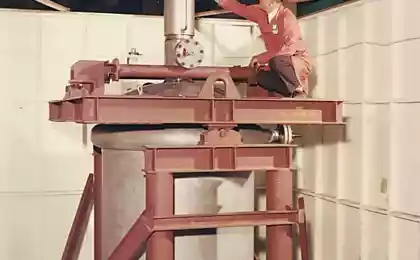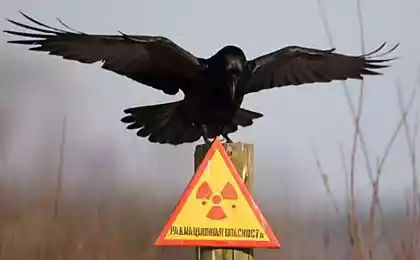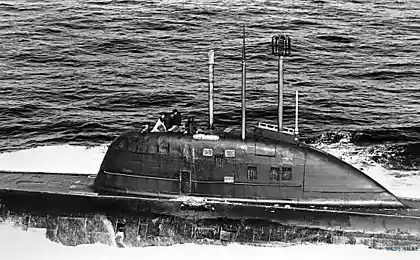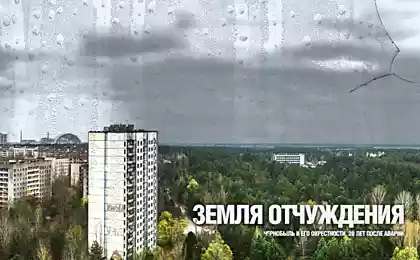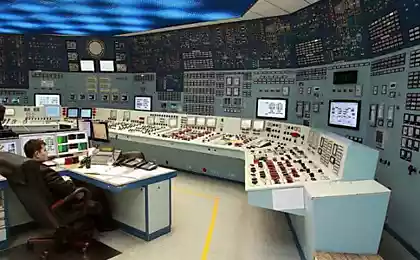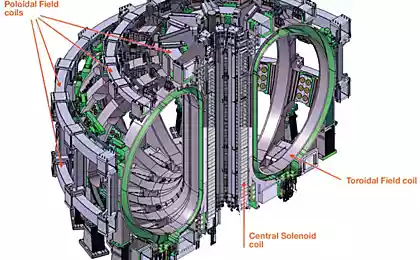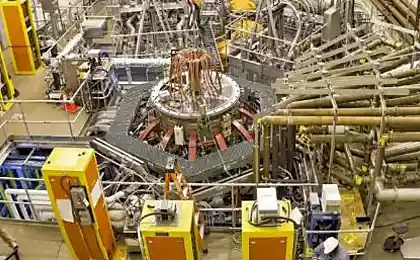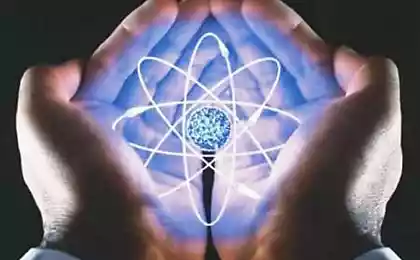615
In the depths of the reactor termoyadrёnogo
One LJ istu named Stanislav V. Mikov Ljdtkjcm visit an experimental laboratory for thermonuclear fusion, built back in the 1999th year. And he hastened to share pictures from the Internet community
11 ph + letter. Quite scientific letters
Tokamak - a toroidal device for magnetic plasma confinement. Plasma chamber walls is not held, that it is not able to withstand the temperature and specifically generated magnetic field. Feature tokamak is the use of electric current flowing through the plasma to create a poloidal field required for plasma equilibrium. In this it differs from the stellarator, where both toroidal and poloidal field is generated by magnetic coils.
Tokamak "Globus-M ', the Ioffe Institute. AF Ioffe. Built in 1999

Theoretical basis of the fusion reactor, where the plasma would have the shape of a torus and held by the magnetic field, were developed in 1951, Tamm and Andrei Sakharov. Beautiful term "Tokamak" was coined later, Igor Golovin, a disciple of Academician Kurchatov. Initially, it sounded like "tokamag" - short for "toroidal magnetic chamber", but NA Yavlinsky, the author of the first toroidal system, proposed to replace "-mag" to "-mak" for euphony. Later this version was borrowed from all languages. The first tokamak was built in 1955, and for a long time tokamaks only existed in the USSR. Only after 1968, when the tokamak T-3, built at the Institute of Atomic Energy. AND IN. Under the leadership of Kurchatov Artsimovich at the Institute of Atomic Energy. Kurchatov, the plasma temperature was achieved 10 million degrees, and British scientists with their equipment have confirmed this fact, which at first refused to believe the world began a real boom tokamaks.
Currently tokamak considered the most promising device for controlled thermonuclear fusion

Tokamak is a toroidal vacuum chamber, on which coils are wound to create (toroidal) magnetic field. Because of the vacuum chamber is first evacuated and then filled it with a mixture of deuterium and tritium. Then, with the help of the inductor, the camera creates a vortex electric field. The inductor is a primary winding of a large transformer, wherein the chamber is a secondary winding of a tokamak. The electric field causes a current to flow and the ignition of the plasma in the chamber.
The current flowing through the plasma performs two tasks:
* Heated plasma as well as heating would any other conductor (ohmic heating).
* Creates a magnetic field around itself. This magnetic field is called the poloidal (t. E. Directed along the lines passing through the poles of the spherical coordinate system).
The magnetic field compresses the plasma current is flowing through. This results in a configuration in which a helical magnetic force lines "wrap around" the plasma column. In this step while rotating in the toroidal direction does not coincide with a pitch in the poloidal direction. Magnetic lines are not closed, they are infinitely many times curled around the torus to form t. N. "Magnetic surfaces" toroidal shape.
The presence of the poloidal field is necessary for a stable plasma confinement in such a system. Since it is created by increasing the current in the inductor, and he can not be infinite, while the existence of a stable plasma in a tokamak classic limited. To overcome this limitation, additional developed ways to maintain the current. This may be used in the injection of plasma accelerated neutral atoms deuterium or tritium, or microwave radiation.
Besides toroidal coils to control the plasma column, additional poloidal field coils. They are circular coils around the vertical axis of the tokamak chamber.
Only one heat due to the current flow is not sufficient to heat the plasma to the temperature required for the fusion reaction. For additional heating using microwave radiation at t. N. resonant frequencies (eg

Through the window I could see the inner surface of the chamber.

In the center - a white console with the main "red button".

The main parameters of the experiment Globe-M:
large plasma radius: 0.36 m
small plasma radius: 0.24 m
plasma volume: 0.5 m3
plasma elongation in the vertical direction, up to 2.1
magnetic field of 0.4 T
current in the plasma: up to 0.36 AI
plasma heating power: up to 1.7 MW
the overall diameter of the installation: 2m
Overall height: 2.5 m

ITER is much safer nuclear reactor in relation to radiation. First of all, there are the number of radioactive substances is relatively small. The energy that can be released as a result of an accident, too small and can not lead to the destruction of the reactor. At the same time, in the reactor design has few natural barriers to the spread of radioactive substances. For example, the vacuum chamber and cryostat shell must be sealed, otherwise the reactor will be unable to work. However, when the design of ITER paid much attention to radiation safety during normal operation and during potential accidents.
There are several possible sources of contamination:
* Radioactive isotope of hydrogen - tritium
* Radioactivity induced in the materials of the installation as a result of neutron irradiation
* Radioactive dust formed as a result of exposure to the plasma to the first wall
* Radioactive corrosion products, which may be formed in the cooling system
In order to prevent the spread of dust and tritium if they extend beyond the vacuum chamber and the cryostat, a special ventilation system will be maintained in the reduced pressure reactor building. Therefore, the building is not air leakage except through the filter ventilation.
During the construction of the reactor, where possible, be applied materials, already tested in the nuclear power industry. Because of this, induced radioactivity is relatively small. In particular, even in case of failure of cooling systems, natural convection is sufficient for cooling the vacuum chamber and other design elements.
Estimates show that even in the event of an accident, radioactive emissions will not pose a danger to the public and will not cause the need for evacuation.

Previously created experimental tokamaks (toroidal chamber with magnetic coils) intended for research in the field of controlled thermonuclear reaction, very cumbersome and expensive. "Globe-M" - Russia's first experimental setup for the study of plasma in a spherical chamber (diameter of a sphere - 1, 5 m).
Experiments with the "Globe-M" have shown that the stability of the plasma to the most dangerous types of magneto-hydrodynamic disturbances is much higher than in conventional tokamaks. The fact that the main obstacle to the creation of an industrial fusion reactor are anomalous heat loss due to plasma turbulence. Go plasma in a state with low turbulence results in an abrupt increase in energy confinement time. In this mode, the retention time can heat 6-10 times greater than the values characteristic of "normal" tokamak.
"Globe-M" commissioned by MIPT was made at the St. Petersburg "Northern Factory", the largest enterprise of the defense industry, where in the early 20th century were built the first Russian heavy aircraft design Igor Sikorsky. Russia "Globus-M" is estimated at 5 million. USD., Which were obtained by the grant of the International Science and Technology Center (ISTC).
Results of experiments Tokamak at Petersburg, to be used in the project of the International Thermonuclear Reactor (ITER).

Lower technical floor. Tokamak is mounted on a tripod of metal, painted in yellow color

...

Source:
11 ph + letter. Quite scientific letters
Tokamak - a toroidal device for magnetic plasma confinement. Plasma chamber walls is not held, that it is not able to withstand the temperature and specifically generated magnetic field. Feature tokamak is the use of electric current flowing through the plasma to create a poloidal field required for plasma equilibrium. In this it differs from the stellarator, where both toroidal and poloidal field is generated by magnetic coils.
Tokamak "Globus-M ', the Ioffe Institute. AF Ioffe. Built in 1999

Theoretical basis of the fusion reactor, where the plasma would have the shape of a torus and held by the magnetic field, were developed in 1951, Tamm and Andrei Sakharov. Beautiful term "Tokamak" was coined later, Igor Golovin, a disciple of Academician Kurchatov. Initially, it sounded like "tokamag" - short for "toroidal magnetic chamber", but NA Yavlinsky, the author of the first toroidal system, proposed to replace "-mag" to "-mak" for euphony. Later this version was borrowed from all languages. The first tokamak was built in 1955, and for a long time tokamaks only existed in the USSR. Only after 1968, when the tokamak T-3, built at the Institute of Atomic Energy. AND IN. Under the leadership of Kurchatov Artsimovich at the Institute of Atomic Energy. Kurchatov, the plasma temperature was achieved 10 million degrees, and British scientists with their equipment have confirmed this fact, which at first refused to believe the world began a real boom tokamaks.
Currently tokamak considered the most promising device for controlled thermonuclear fusion

Tokamak is a toroidal vacuum chamber, on which coils are wound to create (toroidal) magnetic field. Because of the vacuum chamber is first evacuated and then filled it with a mixture of deuterium and tritium. Then, with the help of the inductor, the camera creates a vortex electric field. The inductor is a primary winding of a large transformer, wherein the chamber is a secondary winding of a tokamak. The electric field causes a current to flow and the ignition of the plasma in the chamber.
The current flowing through the plasma performs two tasks:
* Heated plasma as well as heating would any other conductor (ohmic heating).
* Creates a magnetic field around itself. This magnetic field is called the poloidal (t. E. Directed along the lines passing through the poles of the spherical coordinate system).
The magnetic field compresses the plasma current is flowing through. This results in a configuration in which a helical magnetic force lines "wrap around" the plasma column. In this step while rotating in the toroidal direction does not coincide with a pitch in the poloidal direction. Magnetic lines are not closed, they are infinitely many times curled around the torus to form t. N. "Magnetic surfaces" toroidal shape.
The presence of the poloidal field is necessary for a stable plasma confinement in such a system. Since it is created by increasing the current in the inductor, and he can not be infinite, while the existence of a stable plasma in a tokamak classic limited. To overcome this limitation, additional developed ways to maintain the current. This may be used in the injection of plasma accelerated neutral atoms deuterium or tritium, or microwave radiation.
Besides toroidal coils to control the plasma column, additional poloidal field coils. They are circular coils around the vertical axis of the tokamak chamber.
Only one heat due to the current flow is not sufficient to heat the plasma to the temperature required for the fusion reaction. For additional heating using microwave radiation at t. N. resonant frequencies (eg

Through the window I could see the inner surface of the chamber.

In the center - a white console with the main "red button".

The main parameters of the experiment Globe-M:
large plasma radius: 0.36 m
small plasma radius: 0.24 m
plasma volume: 0.5 m3
plasma elongation in the vertical direction, up to 2.1
magnetic field of 0.4 T
current in the plasma: up to 0.36 AI
plasma heating power: up to 1.7 MW
the overall diameter of the installation: 2m
Overall height: 2.5 m

ITER is much safer nuclear reactor in relation to radiation. First of all, there are the number of radioactive substances is relatively small. The energy that can be released as a result of an accident, too small and can not lead to the destruction of the reactor. At the same time, in the reactor design has few natural barriers to the spread of radioactive substances. For example, the vacuum chamber and cryostat shell must be sealed, otherwise the reactor will be unable to work. However, when the design of ITER paid much attention to radiation safety during normal operation and during potential accidents.
There are several possible sources of contamination:
* Radioactive isotope of hydrogen - tritium
* Radioactivity induced in the materials of the installation as a result of neutron irradiation
* Radioactive dust formed as a result of exposure to the plasma to the first wall
* Radioactive corrosion products, which may be formed in the cooling system
In order to prevent the spread of dust and tritium if they extend beyond the vacuum chamber and the cryostat, a special ventilation system will be maintained in the reduced pressure reactor building. Therefore, the building is not air leakage except through the filter ventilation.
During the construction of the reactor, where possible, be applied materials, already tested in the nuclear power industry. Because of this, induced radioactivity is relatively small. In particular, even in case of failure of cooling systems, natural convection is sufficient for cooling the vacuum chamber and other design elements.
Estimates show that even in the event of an accident, radioactive emissions will not pose a danger to the public and will not cause the need for evacuation.

Previously created experimental tokamaks (toroidal chamber with magnetic coils) intended for research in the field of controlled thermonuclear reaction, very cumbersome and expensive. "Globe-M" - Russia's first experimental setup for the study of plasma in a spherical chamber (diameter of a sphere - 1, 5 m).
Experiments with the "Globe-M" have shown that the stability of the plasma to the most dangerous types of magneto-hydrodynamic disturbances is much higher than in conventional tokamaks. The fact that the main obstacle to the creation of an industrial fusion reactor are anomalous heat loss due to plasma turbulence. Go plasma in a state with low turbulence results in an abrupt increase in energy confinement time. In this mode, the retention time can heat 6-10 times greater than the values characteristic of "normal" tokamak.
"Globe-M" commissioned by MIPT was made at the St. Petersburg "Northern Factory", the largest enterprise of the defense industry, where in the early 20th century were built the first Russian heavy aircraft design Igor Sikorsky. Russia "Globus-M" is estimated at 5 million. USD., Which were obtained by the grant of the International Science and Technology Center (ISTC).
Results of experiments Tokamak at Petersburg, to be used in the project of the International Thermonuclear Reactor (ITER).

Lower technical floor. Tokamak is mounted on a tripod of metal, painted in yellow color

...

Source:

